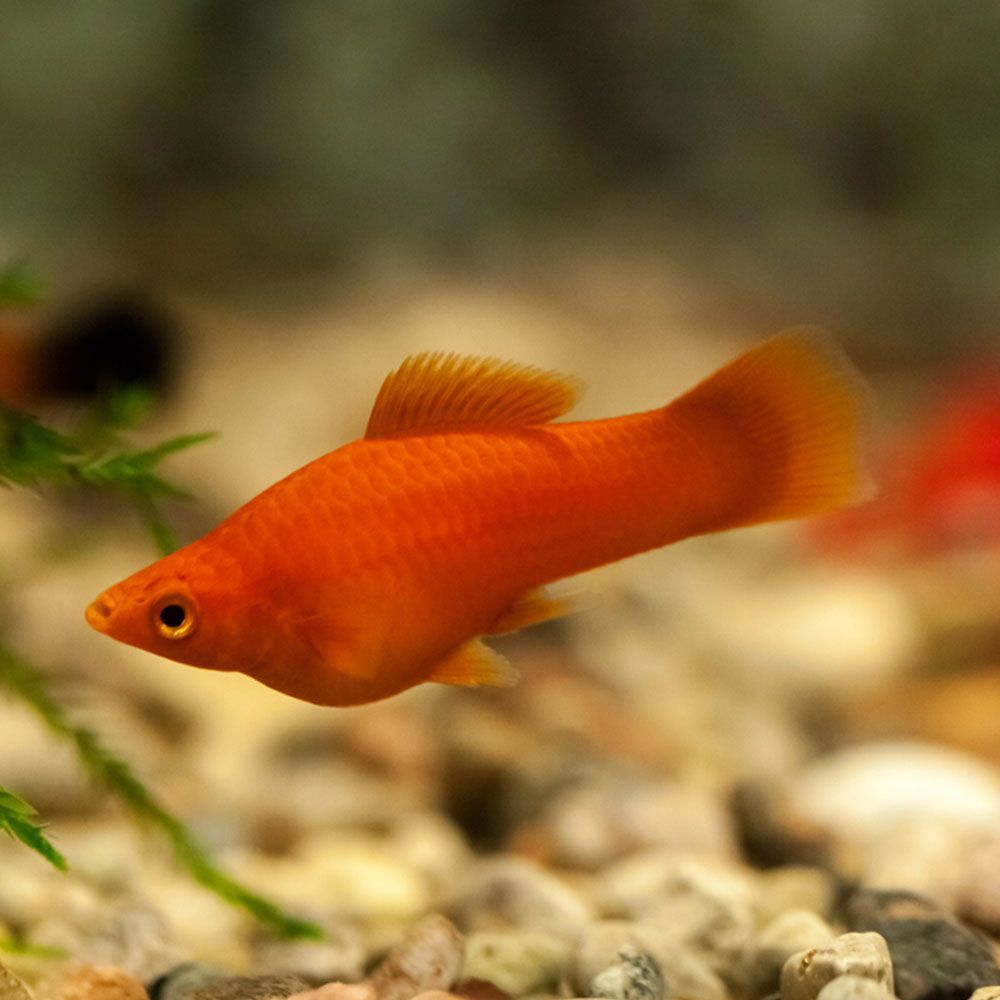If you are looking for a colorful and active fish for your freshwater tank, platy fish will be your best pick. The species is harmonious in nature and is super easy to care for.
Watching the fish in action can be extremely entertaining. Its lively behavior, especially during feeding time, adds a dynamic and engaging element to your aquarium.
What is a Platy Fish?
Platy fish is a freshwater fish full of colors belonging to the Poeciliidae family.
| Origin | North and Central America: Ciudad Veracruz, Mexico to northern Belize |
| Order | Cyprinodontiformes |
| Family | Poeciliidae |
| Scientific Name | Xiphophorus maculatus |
| Common Names | Southern platyfish, platy and Moonfish |
| IUCN Red List Status | Data Deficient |
| Appearance | Short, flattened, and thick bodies tapering towards the tail, triangular head, pointed nose, large eyes, brown to olive color with a subtle sparkle |
| Size | Male: up to 4 cm (1.5 in), female: up to 6 cm (2.4 in) |
| Lifespan | Up to 5 years with the best care |
| Temperament | Peaceful |
| Tank Level | Upper and mid-level |
| Water Temperature | 22-27 °C (72-81 °F) |
| pH Level | 7-8 |
| Water Hardness | 7-20 dGH |
| Care Level | Very easy |
| Minimum Tank Size | 4 adults in a 25-gallon tank |
| Tank Environment | Heavily planted tank, a lot of open swimming space, minimal decor like rocks and driftwood |
| Diet | Omnivorous |
| Tank Mates | Peaceful species of similar or smaller size |
What is the Natural Habitat of Platy Fish?
Southern platy is originally found in Veracruz, Mexico, and northern Belize in North and Central America.
People have introduced the fish to some parts of the United States, including California, Colorado, Florida, Hawaii, Louisiana, Montana, Nevada, Texas, and Puerto Rico.
The fish prefers warm water environments with slow-moving currents, typically found in canals, ditches, and swamps.
It often forms small groups and occupies the lower region of the water. While it mostly lives in freshwater, it can handle a bit of salinity as well.
Southern platies have been listed as Data Deficient on the IUCN Red List in 2018.
Did you know? The fish is used for genetic research, cancer research, and environmental studies due to its diverse traits, its susceptibility, and its ability to show how pollutants affect aquatic life respectively.
Which family does Platy Fish belong?
The fish belongs to the family Poeciliidae under the Cyprinodontiformes order and is the type species of its genus. Its scientific name is Xiphophorus maculatus, and goes by several common names, including southern platyfish, common platy, and moonfish.
The Xiphophorus genus mainly comprises platies and swordtails (Type species: Green swordtail (Xiphophorus helleri)).
These were initially included in a different genus – Platypoecella.
In this genus, there are two notable species, southern and variable platyfish. While this article will revolve around southern platyfish, let’s know about the other at a glimpse here:
Variable Platy Fish (Xiphophorus variatus)
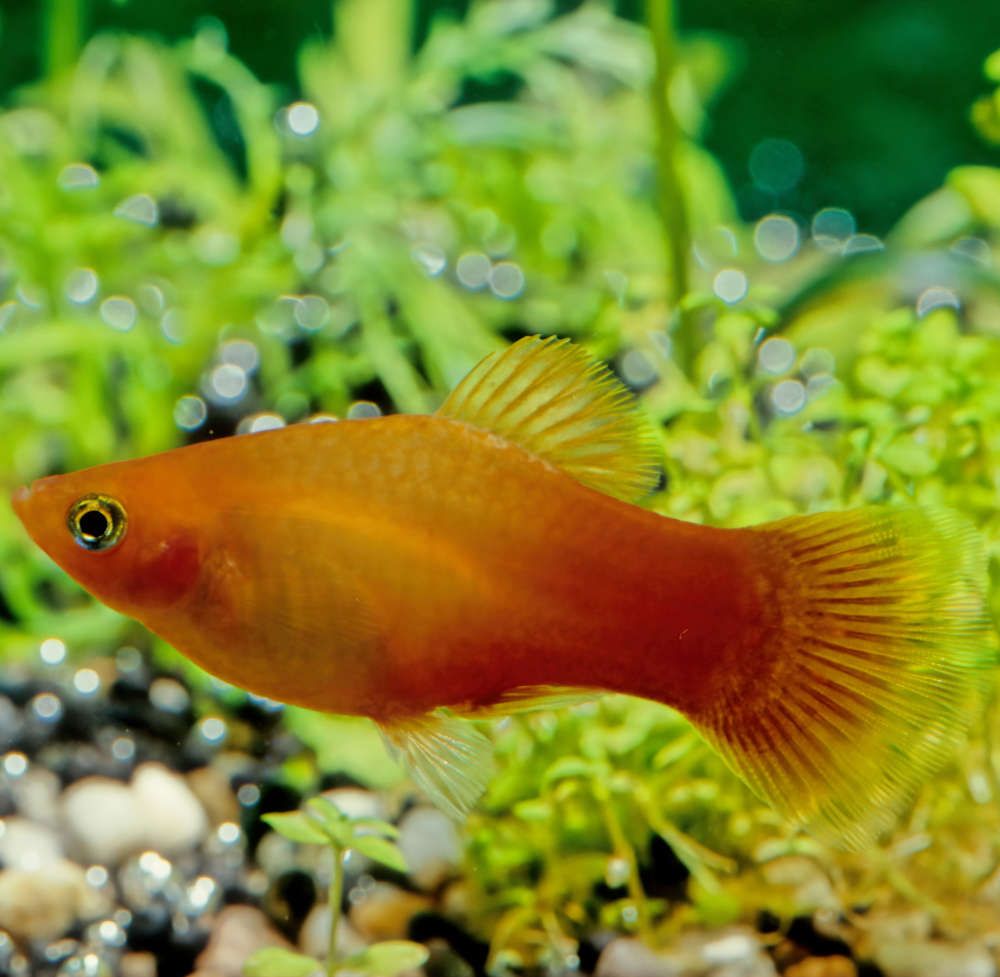
- Common Names: Variegated platy, variable platyfish, sunset platy
- Size: Females: Up to 7 cm (2.8 in), males: Up to 5 cm (2 in)
- Lifespan: 3-5 years
- Tank Level: Middle and top dwellers
- Temperament: Peaceful, non-territorial, prefers conspecific company. Keep one male with multiple females.
- Diet: Omnivorous, primarily carnivorous
- Tank Mates: Similar-sized peaceful community fish and some invertebrates
- Minimum Tank Size: 15 gallon
In the wild, the fish has an olive body with black marbling or spots on the sides. Adult males have black blotches on their dorsal fins and a serrated fourth pectoral ray. They typically have around 20 to 24 scales on their sides and 10 to 12 rays on their dorsal fins.
Further, males have a pointed anal fin, while females have a triangular one. Females are also larger than males.
The variable platyfish come from Mexico and are well-known for their abundant breeding and ability to mix and breed with southern platies easily.
How does a Platy Fish look?
Now, if you want to know how southern platy look and behave, let’s explore them in more detail.
What is the Size of Platy Fish?
On average, the female fish grows up to a potential maximum size of 6 cm (2.4 in) while the male is slightly smaller, i.e., around 4 cm (1.5 in).
What is the Color of Platy Fish?
In the wild, the southern platy fish were originally brown to olive with a subtle sparkle. But through selective breeding, they now come in a wide array of vibrant colors.
What are the Types of Platy Fish?
There are many other popular color variants of this species. Even though all of them are known by the same scientific name, they differ by color, patterns, and even fin types. So, let’s learn about some of them here:
1. Mickey Mouse Platy
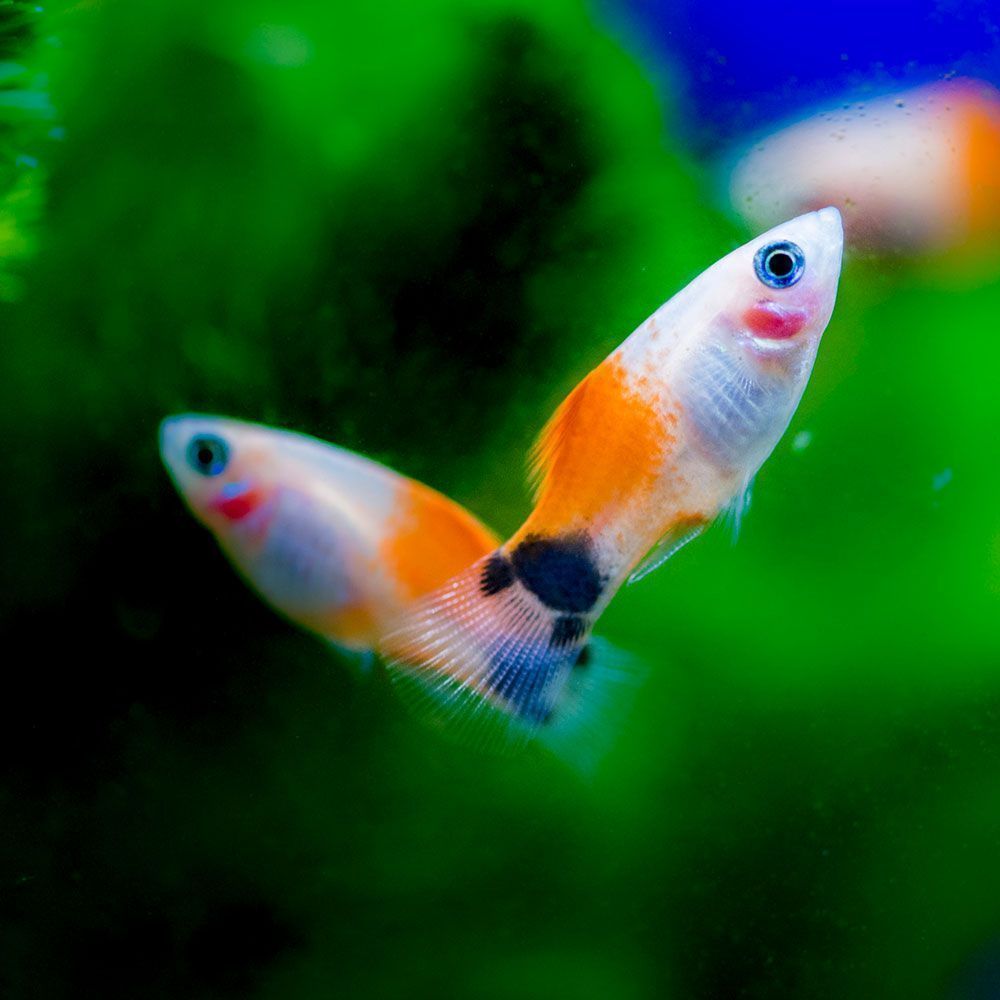
This fish has a unique mark on its tail that resembles Mickey Mouse’s head. It comes in various colors, including gold, red, pale yellow, orange, and occasionally blue.
Its fins may display shades of pale yellow, red, or a hint of black. With a short, stout body and a sleek appearance, it features triangular heads and fan-shaped tails.
Females are larger than the males. Males have an anal fin called gonopodium, used for mating. Females have rounder bellies when carrying fry and are less colorful than males.
2. Sunburst Platy

Known for its vibrant pattern and coloration that gives the illusion of a sunrise. The front half of its body is light yellowish-orange, gradually transitioning into a bright orange hue on the back half.
It comes in various fin types and patterns, including wag, pin tail, and high fin varieties. It’s often confused with the sunset platy.
3. Red Wag Platy
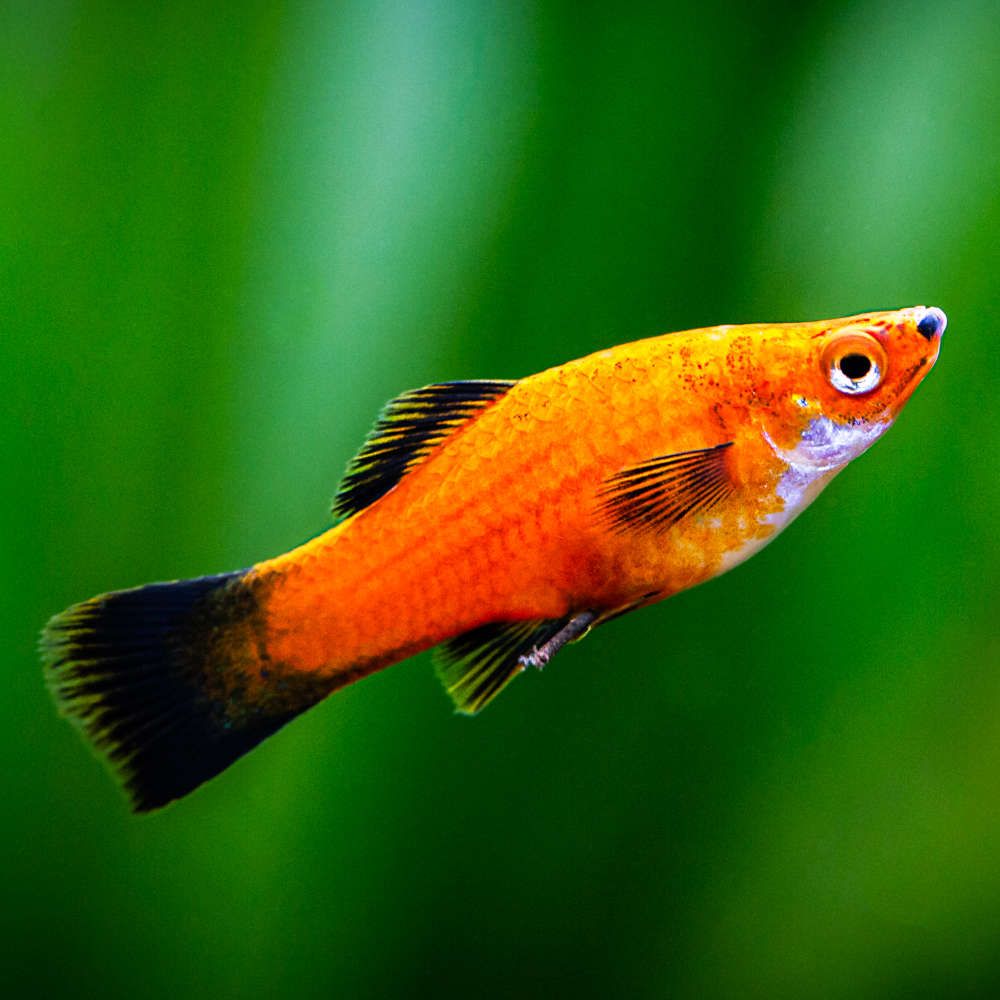
It has a vibrant red-orange coloration on its body, with striking coal-black anal, dorsal, and tail fins.
In terms of size, females can reach up to 3 inches, displaying slightly larger dimensions than their male counterparts, which typically grow to around 2 inches.
4. Bumblebee Platy
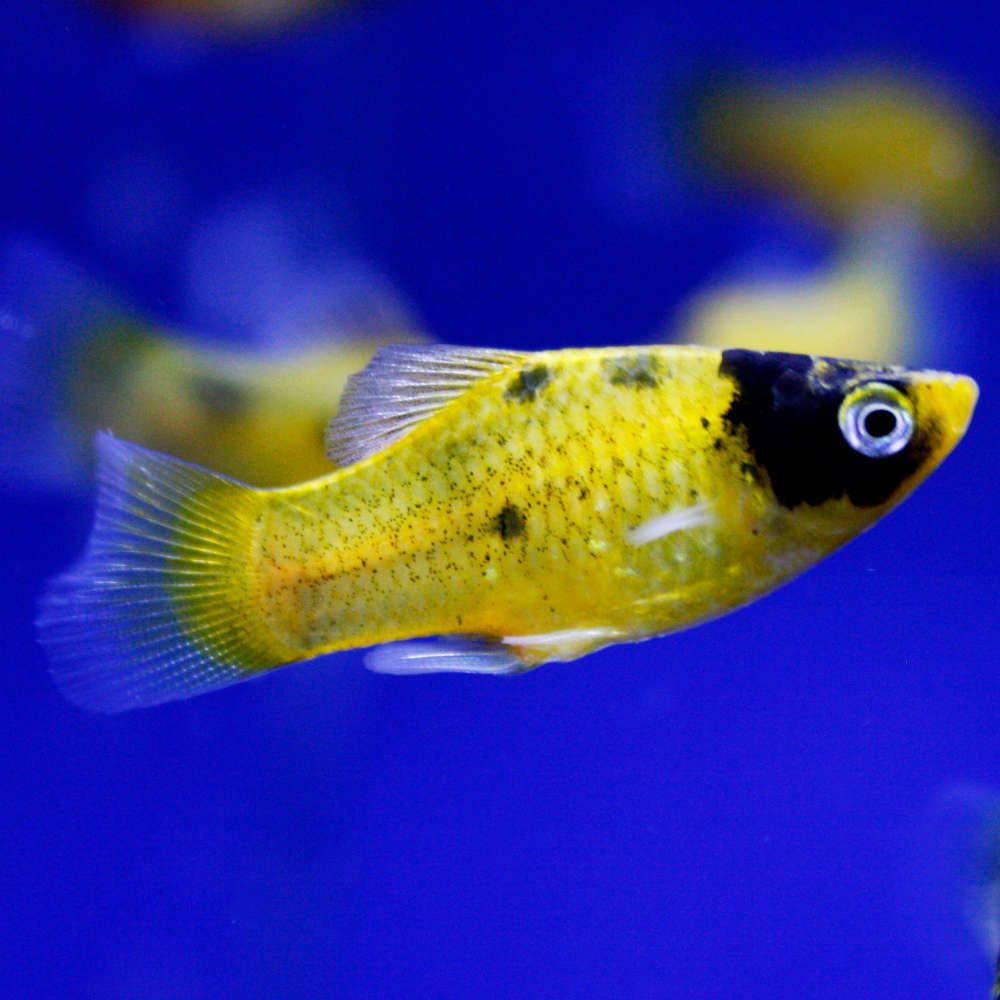
The fish has bright yellow lips, black eyes with yellow eyelids, and a dark black front with hints of green.
It has a torpedo-shaped body, and the pectoral, caudal, and dorsal fins are translucent yellow, resembling bumblebees.
Females are rounder with a rounded anal fin, while males are longer and thinner with a pointed anal fin called gonopodium used during mating.
5. Panda Platy
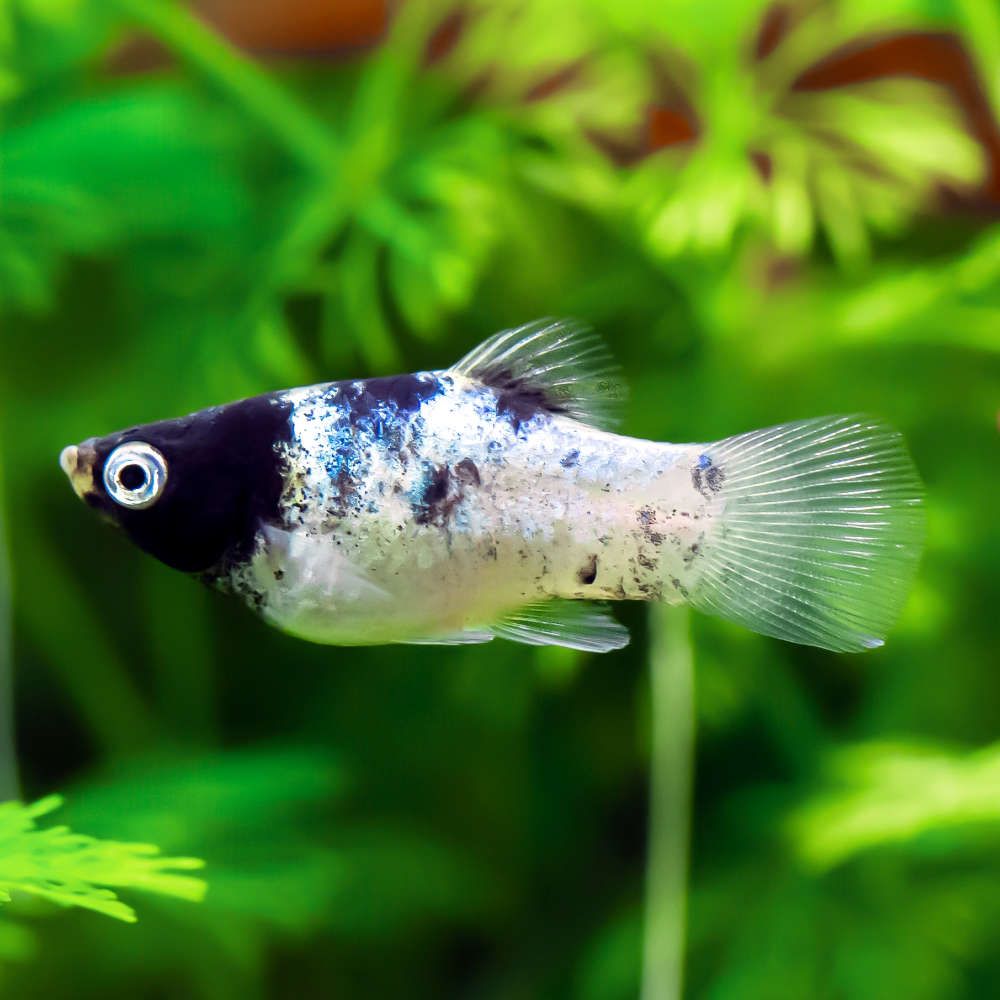
The fish has an entirely white body with distinctive black spots scattered throughout, resembling a panda bear. It has coal-black fins and a tail.
The head and base of the caudal fin are black. These fish are small and have a silvery-white iris.
Males can grow up to about 3.5-4 cm, while females can reach up to 6 cm. You can spot males by their elongated gonopodium, which is near the tail.
What are the Features of Platy Fish?
The platy fish has a short, flattened, and thick body that tapers towards its tail. It has a triangular head, pointed nose, and large eyes. It also sports 8 to 10 soft dorsal rays.
The fins, including dorsal, anal, and caudal, are small and fan-shaped.
How does a male and female Platy Fish differ?
The female fish is larger than the male and has a dark gravid spot on its belly. Its body is rounder with a rounded anal fin that looks like the pelvic fin.
The male fish has a unique reproductive rod-like anal fin called a gonopodium.
What is the Behavior of Platy Fish in a tank?
Southern platies are very peaceful and sociable, rarely showing aggression towards other animals.
However, males can be too assertive with females, causing stress and harm. It’s important to create hiding spots with plants to protect the females.
The fish likes living in small groups and spends most of its time swimming around to release energy and foraging for food. It can typically be found near the surface, in areas with lots of vegetation and organic matter.
What is the Lifespan of Platy Fish?
Under proper care, this fish can live up to 5 years.
Author’s Note: Fit a secure tank lid to prevent them from jumping out of the tank
How to take care of Platy Fish?
If you’re eager to get one of them in your tank, let’s dive into the proper care guidelines to ensure its well-being!
What is the Tank Size of Platy Fish?
A 25-gallon tank provides sufficient space for a group of 4 adult platies to thrive. Some recommend a 10-gallon tank, but these have a high water flow rate, which stresses the fish.
What is the Water Chemistry for Platy Fish?
While these fish are quite hardy, it’s essential to maintain stable water conditions to reduce the risk of disease and stress.
- pH Levels: 7-8
- Water Temperature: 22-27°C (72-81 °F)
- Water Hardness: 7-20 dGH
- Ammonia: 0 ppm
- Nitrite: 0 ppm
- Nitrate: Below 30 ppm
What is the Tank Environment for Platy Fish?
The perfect tank environment is essential for the safety and well-being of your southern platies. Here’s your comprehensive guide to achieving this.
Which Substrate does Platy Fish need?
Platies aren’t picky about their substrate. You can use gravel, sand, or even keep the bottom bare. For a natural look of your aquarium and healthy plants, use fine-grained substrate with nutrients.
You can also choose dark-colored substrates as they make the vibrant fish stand out and mimic their natural habitat.
Which Plants does Platy Fish need?
The southern platy prefers a highly planted tank with open areas that mimic its natural habitat. They also act as hiding places, resting spots, and shelter for fry, reducing the risk of them being eaten by adults. The fish also enjoys playing among the roots of the plants.
So, some great options for this tank are:
- Hornwort
- Duckweed
- Java moss
- Pothos
- Amazon sword
- Anubias
- Cabomba
- Egeria
- Myriophyllum
- Cryptocoryne
What type of Lighting does Platy Fish need?
Your fin-buddy will be the happiest with sunlight, and if you can provide ample of that, you won’t need artificial lights. However, if you choose to use lights, in my experience, it is best to provide 18 hours of light and 6 hours of darkness daily.
What is the Décor of Platy Fish?
These fish dart playfully from within the gaps in the decors. While caves aren’t necessary, other decor options are welcome. You can add rocks or driftwood pieces. But keep it balanced, i.e., leave the tank’s central area open.
What is the Filtration system that Platy Fish needs?
Choose a filter with a large biomedia capacity to support beneficial bacteria. Hang-on-back and internal power filters work well for small to medium community tanks, while canister filters maintain a clutter-free tank. You can also use air stones to enhance oxygenation.
What is the Water Flow Rate for Platy Fish tank?
The platy fish prefers slow and stagnant waters, so select filters with weak outputs or modify strong ones.
Fish Care Tip: Platy fish eat a lot and can make the water dirty. Change 30% of the water in your aquarium every 15 days.
What does Platy Fish eat?
In the wild, the platy fish primarily forages for worms, crustaceans, insects, shrimps, and detritus.
In aquariums, southern platies are omnivorous. They graze on algae and plant material. They are not picky eaters and accept a variety of foods. Feed them with a balanced diet of the following:
- General omnivore flake food
- Brine shrimp
- Blood worms
- Squash
- Zucchini
- Chopped earthworms
- Spinach
- Cucumber
- Lettuce
- Tubifex
- Crushed tubule
- Microworms
- Daphnia
- Micro pellets
- Frozen food
- Freeze-dried foods
- Spirulina
- Kelp
- Algae meal
- Seaweed
- Dandelion leaves
- Oatmeal
- Millet
Being voracious eaters, these fish will eagerly swim to the surface when food is added to the tank. If you have a large group, place food in multiple locations to ensure everyone gets a share.
Feed adult platies once or twice daily. You should fast them for a day each week to mimic natural feeding patterns and prevent overfeeding.
What are the Tank Mates for Platy Fish?
Platy fish thrive best when accompanied by peaceful, similarly-sized fish that won’t cause them any trouble. You can house them with the following:
- Honey gouramis
- Bushynose catfish
- Harlequin rasboras
- Boeseman’s rainbowfish
- White cloud mountain minnows
- Neon tetras
- Ember tetras
- Freshwater angelfish
- Hatchetfish
- Siamese algae eaters
- Rummy nose tetras
- Rosy tetras
- Freshwater goby fish
- Swordtails
- Corydoras catfish
- Glowlight tetras
- Cardinal tetras
- Zebra danios
- Otocinclus catfish
- Celestial pearl danios
They can also be housed with non-fish tank mates like:
- Ghost shrimps
- Zebra nerite snails
- Amano shrimps
- Freshwater snails
Which Tank Mates to Avoid for Platy Fish?
Avoid housing southern platies with the following kinds:
- Aggressive species (e.g.: barbs or cichlids): They may chase, nip, or even injure platy fish, causing them stress and harm.
- Long-finned or slow-moving fish: They may become targets of curiosity or unintentional harassment by platy fish, leading to potential fin nipping or stress.
- Other livebearers: Male fish from the other livebearers may attempt to mate with female fish. This can lead to stress and potential harm to the female fish.
- Larger species (beyond 4 inches or 10 cm): They may bully platy fish, leading to stress and ill health.
What are the Common Diseases in Platy Fish?
Southern platies are generally robust, but they can still be vulnerable to common freshwater illnesses such as ich, fin rot, and columnaris. Moreover, they may also be at risk of various other diseases, some of which are detailed below.
| Disease Name | Causes | Symptoms | Treatment |
|---|---|---|---|
| Dropsy (Pinecone disease) | Internal bacterial infections, often affecting kidneys or the liver. | Swollen belly, protruding scales, lethargy. swollen body, lethargy, loss of appetite, redness or irritation on the skin | Maintain clean water, administer antibiotics, and isolate infected fish. |
| Swim Bladder Disease | Often unclear, possibly linked to diet or stress. | Difficulty swimming, floating upside down, sinking, or having difficulty maintaining balance, a loss of appetite, distended abdomens | Adjust water temperature, consider surgery in severe cases, or euthanasia. |
| Velvet (Oodinium) | Infection by protozoan parasite Oodinium pilularis | golden or rust-colored dust-like specks on fish, excess mucus, rapid gill movement, lethargy, scratching, loss of appetite, color fading, and clamped fins. | Copper-based medication, darkness in the aquarium, and water changes. |
| Camallanus Internal Worm | Internal parasites. | weight loss, a swollen abdomen, red or pink thread-like worms protruding from the fish’s anus, decreased activity, loss of appetite | Levamisole or Fenbendazole treatment, substrate vacuuming, and water changes. |
| Shimmies/ Shimmying | Neurological disorder, often due to poor water quality, improper tank conditions, diseases, or social stress | Erratic swimming, rapid, side-to-side movements, shaking or shimmering, and difficulty breathing. | Improve water quality, adjust tank temperature, and consider salt baths or antibiotics. |
| Wasting Disease | Stress, nutritional deficiencies, bacterial infections, parasitic infestation, or organ dysfunction | Rapid weight loss, lethargy, loss of appetite, stringy or discolored feces, fin damage, and sores. | An improved diet with high-quality food, address water quality, and appropriate medications. |
| Gill Flukes | Parasitic flatworms : Dactylogyrus | including rapid gill movement (flaring), increased mucus production, labored breathing, reduced activity, flashing and hovering near the water’s surface | Antiparasitic medication, medicated baths, formalin dips, or copper-based treatments, isolate infected fish, and maintain water quality. |
| Popeye | Infections, physical injuries, poor water quality | Bulging eyes, reduced appetite, lethargy, or rubbing against tank objects | Antibiotics or antifungal medications, improve water quality, reduce stress, maintain a proper diet |
Quick Tip: Quarantine new fish for about 20 days before introducing them to your main aquarium. Use a small tank (up to 20 liters) with clean water, possibly with methylene blue, and a small air pump.
how to Breed Platy Fish in a tank?

Breeding southern platies is easy as they reproduce pretty easily. So follow the next steps to get healthy fry.
1. Breeding Tank Preparation
Set up a separate 10-20 gallon breeding tank with similar and stable water conditions to your main tank. Add live or artificial plants to provide hiding spots for fry.
2. Specimen Preparations & Mating
Males are polygamous, so having one male with three females is a good mix. Introduce a group of 3-4-month-old specimens to the breeding tank. This is when the fish sexually matures. Provide high-protein meals to trigger spawning.
The female will have a plump, swollen belly when she’s ready to mate. She might also develop a dark gravid spot on her belly.
These are livebearers. The female will release fully-formed fry directly into the water. The gestation period takes 4-6 weeks, and females can produce 40-80 fry.
The male fish internally fertilizes the female fish.
3. Expectant Female Separation
Platies breed every 4 weeks or so in ideal conditions. The female fish can store the male fish’s milt inside her and produce multiple batches of fry.
Adults may eat their own fry. So, let the female fish give birth in a different tank. Return her to the breeding tank immediately after the female has given birth.
Keep an eye on the gravid females in your main tank and transfer them to a separate breeding tank before giving birth. Make sure the fry birthing tank is of equal size with good quality water conditions to avoid stressing the female fish.
4. Fry Care
Feed the fry-appropriate food, such as powdered flake or baby brine shrimp, multiple times a day. A standard twice or thrice-a-day feeding can help them grow the best.
Breeding Tip: Protect fry during gravel cleaning by covering the siphon opening with a material like a clean pair of tights.
How to Buy Platy Fish?
- Choose individuals with bright eyes, full bellies, and active behavior.
- The fish should have clean, rash-free bodies and intact, straightened fins.
- Don’t buy thin or hunched fish.
A word from FishInAquarium
Raising and breeding platy fish in a home aquarium is an immensely rewarding experience. They come in a wide range of colors and patterns, allowing you to create a visually stunning and diverse aquarium.
Their cute and inquisitive appearance, almost resembling cartoon characters come to life, makes your aquatic world more charming.
If you found this information helpful and liked the article, consider sharing it with other fish enthusiasts. And if there are any questions, feel free to reach out via email. Our team will be happy to assist you.

